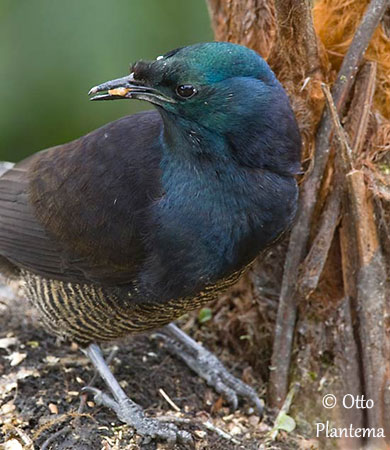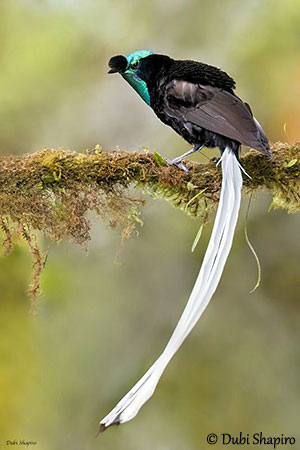
Fr: Paradisier à rubans
Ang: Ribbon-tailed Astrapia
All: Schmalschwanz-Paradieselster
Esp: Ave del Paraíso Cuelgacintas
Ita: Astrapia festonata
Nd: Lintstaartastrapia
Sd: girlandastrapia
Photographers:
Otto Plantema
Trips around the world
Dubi Shapiro
Dubi Shapiro Photo Galleries
Text by Nicole Bouglouan
Sources:
HANDBOOK OF THE BIRDS OF THE WORLD Vol 14 by Josep del Hoyo-Andrew Elliot-David Christie - Lynx Edicions – ISBN: 9788496553507
Les Oiseaux de paradis – Histoire Naturelle et photographies - par Michel Ottaviani - Editions Prin, France – ISBN : 2-909136-40-X
Birds of Paradise and Bowerbirds De Phil Gregory – Editeur: Bloomsbury Publishing, 2020 – ISBN: 1472975847, 9781472975843 – 416 pages
Birds of New Guinea: Second Edition De Thane K. Pratt, Bruce M. Beehler – Editeur: Princeton University Press, 2014 – ISBN: 0691095639, 9780691095639 – 528 pages
Birds of New Guinea: Distribution, Taxonomy, and Systematics De Bruce M. Beehler, Thane K. Pratt – Editeur: Princeton University Press, 2016 – ISBN: 069116424X, 9780691164243 – 672 pages
Book of Curious Birds De Jennifer Cossins – Editeur: Hachette UK, 2021 – ISBN: 073442048X, 9780734420480 – 64 pages
Astonishing Animals: Extraordinary Creatures and the Fantastic Worlds They ... De Tim Flannery – Editeur: Open Road + Grove/Atlantic, 2012 – ISBN: 0802194176, 9780802194176 – 192 pages
Bird: The Definitive Visual Guide De DK – Editeur: Dorling Kindersley Ltd, 2022 – ISBN: 0241596319, 9780241596319 – 512 pages
The Nesting Biology of the Ribbon-tailed Astrapia Astrapia mayeri (Paradisaeidae)
Ribbon-Tailed Astrapia – Most Beautiful Bird of Paradise
Birds of Paradise: Paradisaeidae - Ribbon-tailed Astrapia (astrapia Mayeri): Species Accounts
CREAGUS@Monterey Bay (Don Roberson)
Fatbirder - The World’s Richest Information Resource about Birds for Birders
Wikipedia, the free encyclopaedia
Ribbon-tailed Astrapia
Astrapia mayeri
Passeriformes Order – Paradisaeidae Family
INTRODUCTION:
The Ribbon-tailed Astrapia is endemic to subalpine forests in the western part of the central highlands of Papua New-Guinea. It is the most recently discovered of all birds of paradise. The name “mayeri” pays tribute to Fred Shaw Mayer who sent the tail plumes to the British Museum in 1939 for formal description of this beautiful species.
The Ribbon-tailed Astrapia frequents the mossy forest and edges at high elevations, up to 2,450 metres. It feeds primarily on fruits, but it also takes insects, spiders and frogs.
The male is polygynous and displays at leks with other males. During the displays, the long, white, central rectrices are enhanced by adapted movements. The female alone performs the nesting duties.
The Ribbon-tailed Astrapia is threatened by habitat degradation and hunting for its plumes. It is currently listed as Near Threatened.
DESCRIPTION OF THE BIRD:
Biometrics:
Length: M: 32 cm (125 cm including the central rectrices)
Weight: M: 134-164 g
Length: F: 35 cm (53 cm including central rectrices)
Weight: F: 102-157 g

The Ribbon-tailed Astrapia adult male has velvety, jet black plumage on the upperparts from mantle to uppertail-coverts, with bronze/olive-green iridescent sheen.
On the upperwing, the lesser coverts are darker, brownish-black with jet black edges. Both greater coverts and alula are brownish-black, whereas flight-feathers are blackish-brown.
The uppertail is blackish-brown with two elongated white central rectrices tipped with black on the outermost 3-4 centimetres. These feathers may reach more than 1 metre and 2 centimetres broad. The shaft is blackish for terminal quarter. They resemble two white ribbons, giving the bird its English name.
On the underparts, the throat shows intense metallic yellowish-green feathers with slightly scale-like appearance. They extend onto the upper breast and contrast sharply with the velvety jet black feathers of the breast, showing a dull iridescent copper-bronze sheen. It is bordered below with a dark, coppery-red edging.
Rest of underparts is blackish-brown with reddish tinge on lower breast. Vent and undertail-coverts are matt brownish-black.
The head is entirely velvety jet black with intense, iridescent metallic yellowish-green and/or blue and violet-purple and/or magenta, depending on the light, especially on ear-coverts and elongate feathers at side of head to nape.
The nasal tufts above the base of the upper mandible are of similar colour, forming a striking tuft or pom-pom of black feathers.
The bill is blackish, with pale greenish-yellow mouth. The eyes are dark brown. Legs and feet are dark blue-grey.
The female is smaller with shorter tail showing white along the vanes. Mantle and back are velvety blackish with blue-violet sheen. Rest of plumage is dull blackish-brown. The belly is rufous with fine blackish barring.
Head and nape are jet black with bronzy-blue iridescent colour. The blue iridescence is more conspicuous on the sides of face and lower throat. The nasal tufts are smaller.
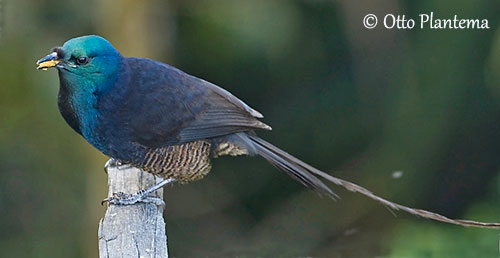
The juvenile resembles female with duller barring on belly. It has soft, fluffy plumage.
The immature has longer wings and tail than female, and the 1st year bird shows duller iridescence.
The subadult male varies, depending on state of moult. It resembles adult female with some male-type feathers.
RANGE:
The Ribbon-tailed Astrapia inhabits a restricted region of Papua New-Guinea’s highlands, in the vicinity of Mount Hagen. It can be found from Doma Peak, upper Strickland R, Müller Range and Karius Range, E to Porgera/Mt Liwaro Highlands, Mt Hagen and Mt Giluwe.
HABITAT:
The Ribbon-tailed Astrapia frequents the upper montane and subalpine mossy forests and forest edges. It can be seen in isolated forest patches and logged or disturbed forest.
The species is visible from 1,800 to 3,450 metres of elevation, but mostly above 2,450 metres.
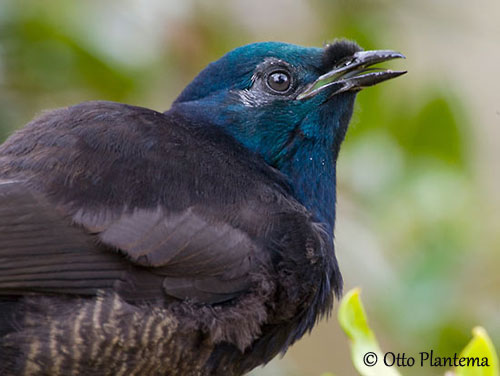
CALLS AND SONGS: SOUNDS BY XENO-CANTO
The common call of the Ribbon-tailed Astrapia is a loud, clear “waugh” and also “wock, whit, whit” with guttural first note whereas the second whistled note is immediately repeated.
The adult male also gives “henk” note and scolding “skaw skaw”.
While displaying and jumping from branch to branch, the adult male produces a harsh “hisss-sss-ssh” followed by a loud, sharp “keaoo-ooo-ooo”. Wing noises are also heard during the displays.
The immature male (with short tail) gives a plaintive, nasal “wreden” or “reaou reaou” described as a frog-like sound.
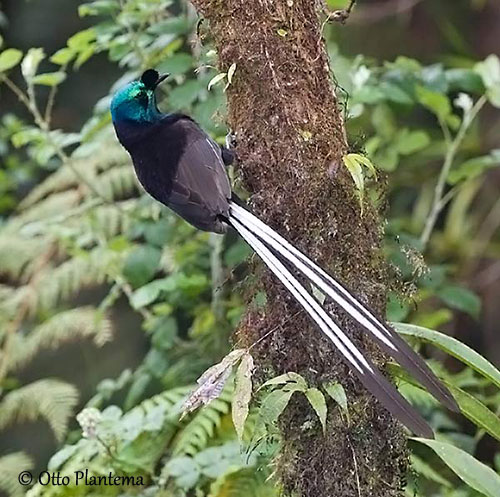
BEHAVIOUR IN THE WILD:
The Ribbon-tailed Astrapia has a varied diet including fruits of genus Schefflera in the family Araliaceae, insects, spiders and frogs.
It forages by hopping about in the canopy of the mossy forest, searching for insects and fruits in trees and shrubs.
However, it may forage at all levels of the forest, and often at mid-level. But it probably comes also to the ground or at low level to find the red fruits of wild ginger.
The adult male often feeds solitary, but 2-3 female-plumaged birds may feed together.
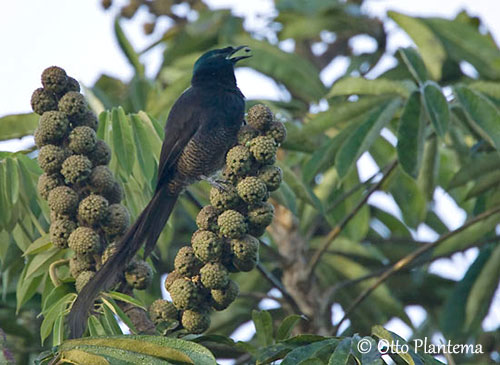
The Ribbon-tailed Astrapia male is polygynous and mates with several females each year. The female performs alone the nesting duties while the male displays to attract other females.
Several males perform a communal courtship display for the females. The male’s displays usually involve jumping between branches while the long white rectrices are arched up behind and over their heads, swishing around dramatically to attract a female.
Some males have been observed spreading a wing and flicking their tails before flying upwards to a perch in the canopy. At this moment, the tail becomes a glittering streamer, making them look like a comet.
Four distinct display behaviours were identified:
The “perch-hop” includes rapid hops from branch to branch accompanied by a wing rattle produced in flight and while hopping back and forth.
The “hunchback-pivot” shows the bird turning from side to side in a special hunched posture. The feathers of the mantle are erect. The rounded tuft of the forehead is also pulsed forwards over the pointing bill. The green metallic feathers are enhanced and contrast with the black neck feathers. While the bird is moving from side to side, the long tail feathers also move in an exaggerated way.
The “upright-sleeked posture” is a ritual posture. The iridescent plumage is held tight against the body. The long tail hangs below the bird, in line with the body axis.
The “branch sidle” is a lateral movement along a branch. The bird adopts a horizontal posture with the bill pointed forwards.
The displays are accompanied by several vocal sounds and wing noises.
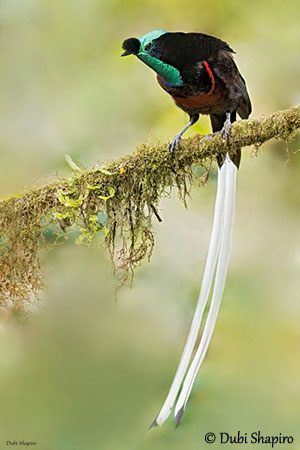
The Ribbon-tailed Astrapia is suspected to be resident, perhaps with some altitudinal movements, but more information is required.
The flight over the forest canopy or open grasslands is an astonishing sight. The bird performs an undulating flight with 4-5 wingbeats before each shallow dip, while the elongated, dark-tipped and white central streamers are rippling out behind, and often spreading out in scissor shape.
The male may also perform aerial displays with loud wing noise. During this strongly undulating flight, the two white rectrices wave conspicuously.
REPRODUCTION OF THIS SPECIES:
The breeding season extends through the year except April. The laying takes place in May, June and September-February. The displays are observed in June, August and December.
The female builds the nest mainly in isolated small tree, often in secondary growth. The nest is a well-defined cup lined with fine rootlets and a few large pieces of thick leaves of nearly 2,50 centimetres long. The foundation of this structure includes a spiral pile of thin, vine-like orchid stems, with sometimes an odd piece of small fern frond used on the outer part.
The nest is placed in near-vertical forking branch, between 3 and 18 metres above the ground. The females often reuse the same nest-site.
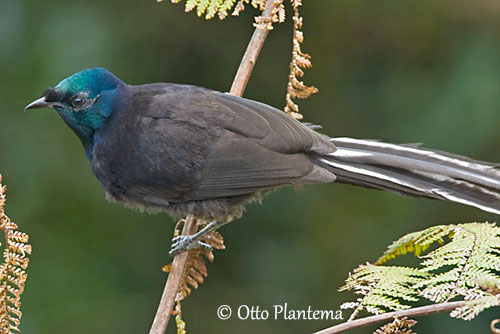
The Ribbon-tailed Astrapia female lays a single egg and incubates alone during about 21 days (observation at one nest in captivity). The duration of this period is uncertain.
The nestling period lasts 25-29 days. The fledging period is believed to be between 22 and 26 days, depending on weather conditions. The female performs alone all the nesting duties, without any help from the male.
PROTECTION / THREATS / STATUS:
The Ribbon-tailed Astrapia has restricted range in which it is described as fairly common, including in degraded forests. The species is reported to be abundant in the West of the range at a new site named Kumul Lodge.
It is locally threatened by hunting for tail plumes, but intense logging and degradation of the forests is also a problem. However, the species appears to be safe in some inaccessible parts of the range.
This range overlaps that of Stephanie’s Astrapia, and hybridisation is reported in extreme East of this range, but the previous concerns about this problem are now discounted.
The size of the population is unknown, but a slow decline is suspected, due to habitat degradation, but the range is not yet heavily fragmented.
The Ribbon-tailed Astrapia is currently classified as Near Threatened.
